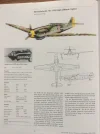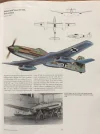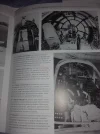Oliko näitä harvinaisempia V-tail mersuja tositoimissa ja jos oli, niin millä menestyksellä?:
Katso liite: 15750
messerschmitt_bf_109_v_tail-69164.jpg
If you are a fan of the Messerschmitt Bf.109, and if you are looking for something a little different to build, UMI (Unlimited Models Inc) offers a conversion for an esoteric subject – the experimental Bf109G-0 V-tail prototype (WkNr 14003). Only the one prototype was produced, and the V-tail design never went into production because it offered no real improvement in performance over the standard tail design. Information on the V-tail Bf.109 is difficult to come by, but here I piece together what I could find or deduce.
http://hsfeatures.com/features04/bf109g0vtail32ir_1.htm
The
Bf 109H was intended to be a high-altitude fighter, developed from the F-series. The
wingspan was increased through the addition of new, constant-chord inner wing panels to 11.92 m (39.11 ft), and the widened stabilizer again received a supporting strut leading from the fuselage, like the B through E models. Maximum speed was 750 km/h (470 mph) at 10,100 m (33,140 ft).[
citation needed][
clarification needed] A small number of Bf 109 H-1s were built, flying several sorties over Britain and France.
Bf 109H-2 and
H-5 developments were also planned, but the entire H-series was scrapped because of wing flutter problems.
[93]
- H-0 (Pre-production aircraft, rebuilt from F-4/Z, powered by a DB 601E engine with GM-1 boost)
- H-1 (Production version, based on G-5 airframes, powered by a DB 605A engine with GM-1 boost)
A record exists of one particular Bf 109H-1,
Werknummer 110073, was recorded as having been converted to a photo-recon aircraft by a Luftwaffe long-range reconnaissance group,
Fernaufklärungsgruppe 123, in May 1944, and flown on dates immediately following the
Invasion of Normandy with one mission meant to scan the entire French coastline from
Cherbourg to
Ouistreham, from an altitude of some 15 km (49,200 ft), which proved to be just beyond the achievable ceiling of the selected aircraft.
[94]
https://en.wikipedia.org/wiki/Messerschmitt_Bf_109_variants
he Bf 109H was an attempt to design a high-altitude fighter to fill a gap in the Luftwaffe inventory left by the failure of the earlier Me 155 and Me 209 projects. The 109H was based on the same fuselage as the Bf 109G. It was to be equipped with a high-altitude pressurized cockpit. The standard 109 wings were lengthened from 9.92m to 13.25m by the addition of a rectangular central section.
The first prototype (Bf 109 V.54) flew on 5 November 1943. Initial tests were satisfactory. A second prototype, the Bf 109 V.55, was destroyed in an air raid on 25 February 1944. Further tests on the V.54 produced less impressive results, but work continued on the project. A small number of the pre-production H-0 and H-1s were produced, and were tested by a reconnaissance unit based at Guyancourt, near Paris, but performance was not satisfactory.
By mid-July production was almost ready to begin, but on 18 July 1944 the project was cancelled by the Air Ministry. Other projects, including the Focke-Wulf Ta 152 and the Messerschmitt Me 262 looked likely to produce better aircraft.
Bf.109H-V-55 Specification
Crew 1
Dimensions
Wing span, m 13.25
Length, m 10.25
Height, m 3.2
Wing area, m² 21.9
Powerplant
PE Daimler-Benz DB-605B, hp. 1600
Weight, kg:
Empty 2880
Maximum takeoff weight 3540
Performance
Maximum speed at altitude 6000 m, km/h 590
Maximum speed at altitude 13500 m, km/h 685
Service ceiling, m 13500
Armament
30-mm MK108 cannon with 60 cartridges, 2 X 20-mm MG-151 cannon with 200 cartridges on each one
Variants
H-0
The H-0 was produced by converting Bf 109F airframes. It was equipped with a DB 601E engine, capable of producing 1350 hp and was armed with 2 MG 18 machine guns and 1 Mk 108 cannon. It was capable of reaching a maximum speed of 750 km/h (466 mph) at 10,100m/ 33,135 feet.
Green: converted from Bf 109F airframes. Issued to a fighter-recon unit near Paris (Guyancourt) in 1944 (as was H-1).
Nowara: 1943. DB 601 E engine, 1350 hp. 2 MG 17 + 1 MK 108
B & N: max speed was 750 km/h/ 466 mph at 10100m/33135 ft
H-1
The H-1 was similar to the H-0. It had DB 601E engine with GM1 power boost, the same combination of two 7.9 mm MG 17 machine guns and an engine mounted cannon (either the MJ 108 or the MG 151/20). This was the last version of the 109H to be produced.
H-2
The 109H-2 was to be produced around the Junkers Jumo 213E “Power Egg” engine. It was to be very heavily armed, with one engine-mounted MK 108 cannon, two 20-mm MG 151 or 13 mm MG 131 guns above the engines and two MG 108 cannon under the wings/
Green: Proposed version with Jumo 213E “Power Egg”. Two suggested varients – one with RB 50/30 or RB 75/30 camera and no guns; the other with a MK 108 cannon in engine, two 20-mm MG 151 above the engine and two 30-mm MK 108 cannon under the wings.
Nowara: project only. Jume 213E engine (1750 hp), 2 MG 131 + 3 MK 108, GM1
H-3
A proposed reconnaissance version, equipped with either the Rb 50/30 or Rb 75/30 camera, the Jumo 213E engine and no guns. This may have been a variant of the H-2.
H-4
A possible fighter-bomber version, with the Jumo 213E engine, 3 Mk108 guns and one 500-kg bomb.
H-5
A proposed version built around the DB 605L engine and armed with 3 MK 108s and 2 MG 131 guns.

















